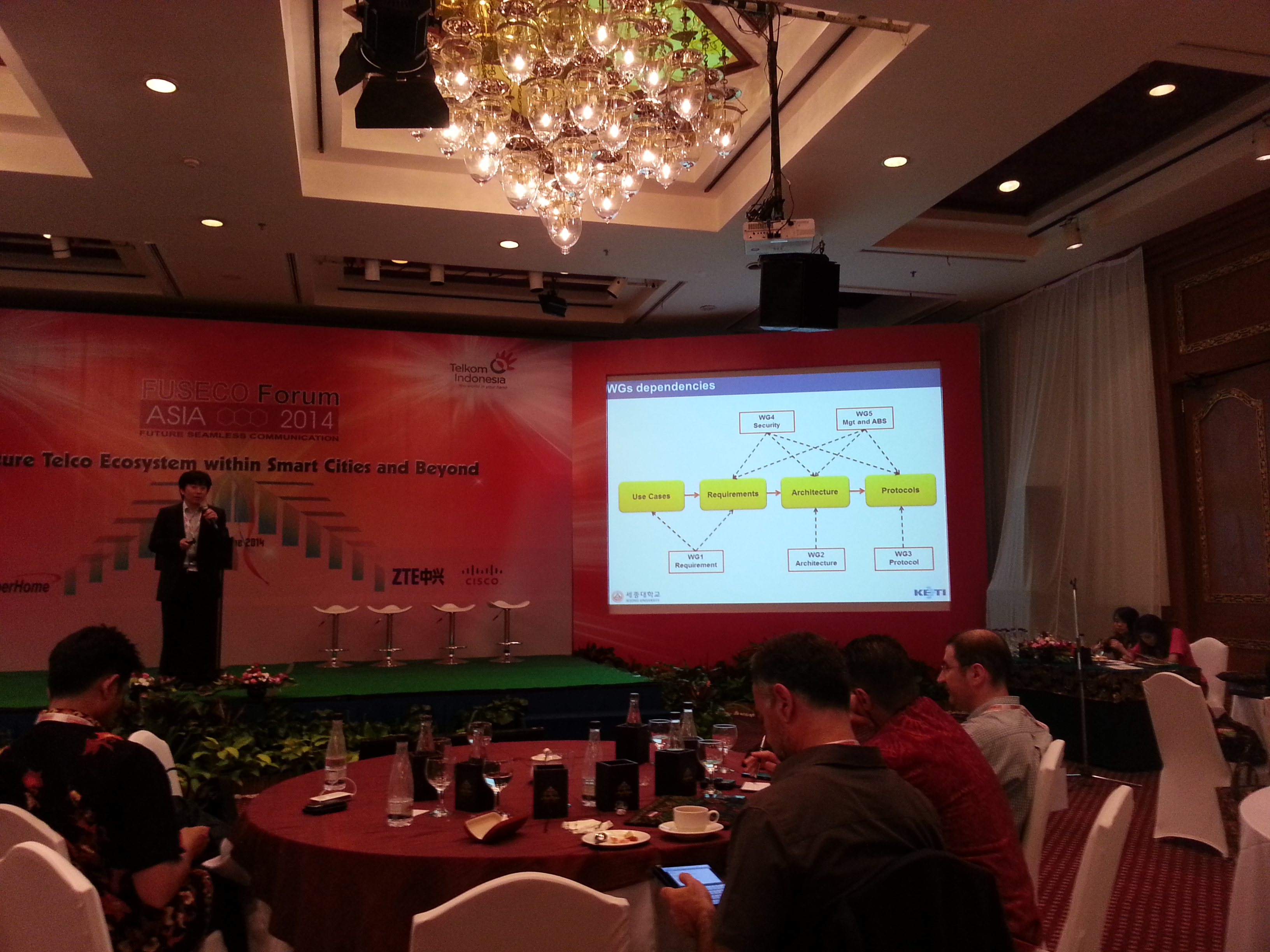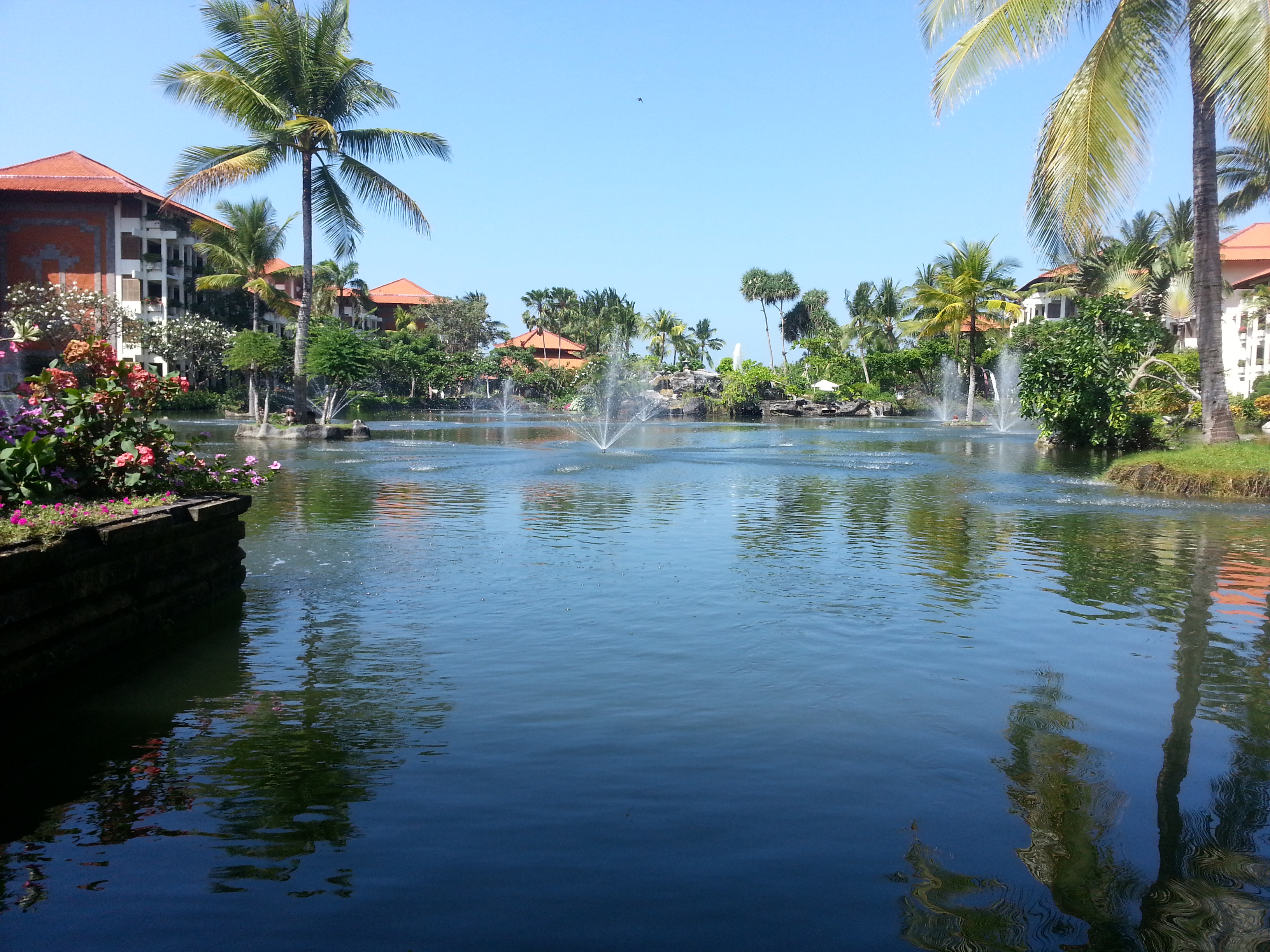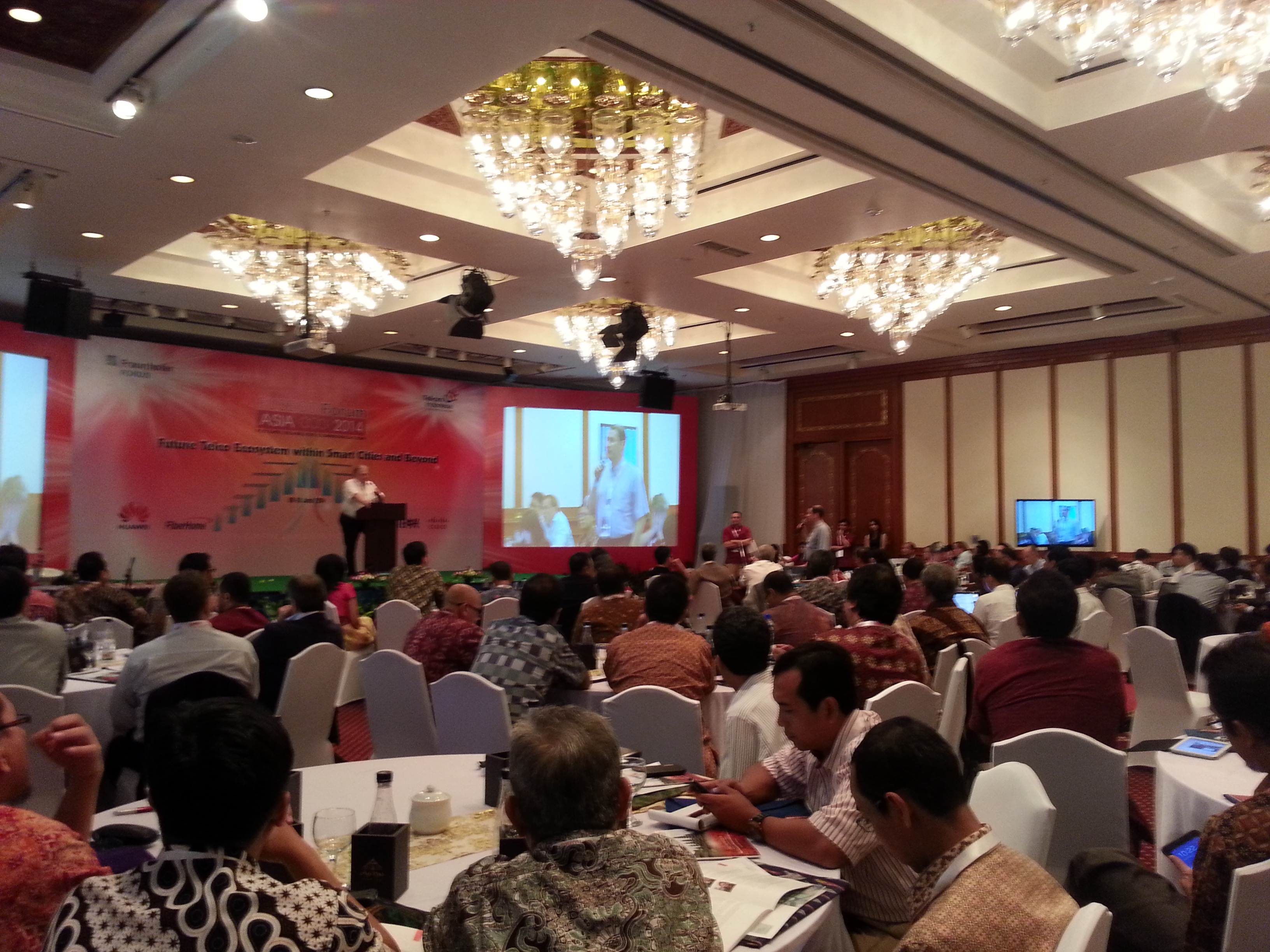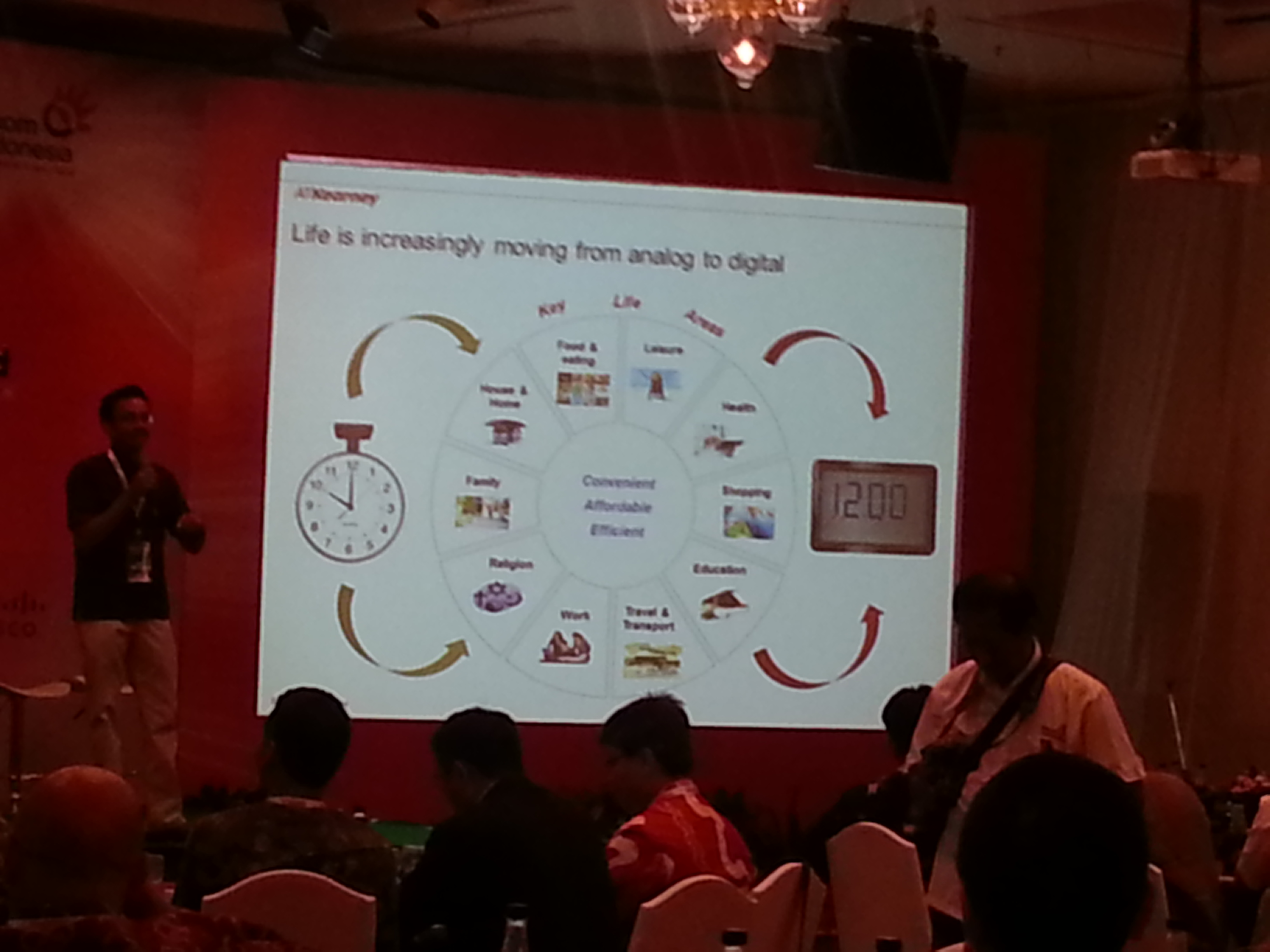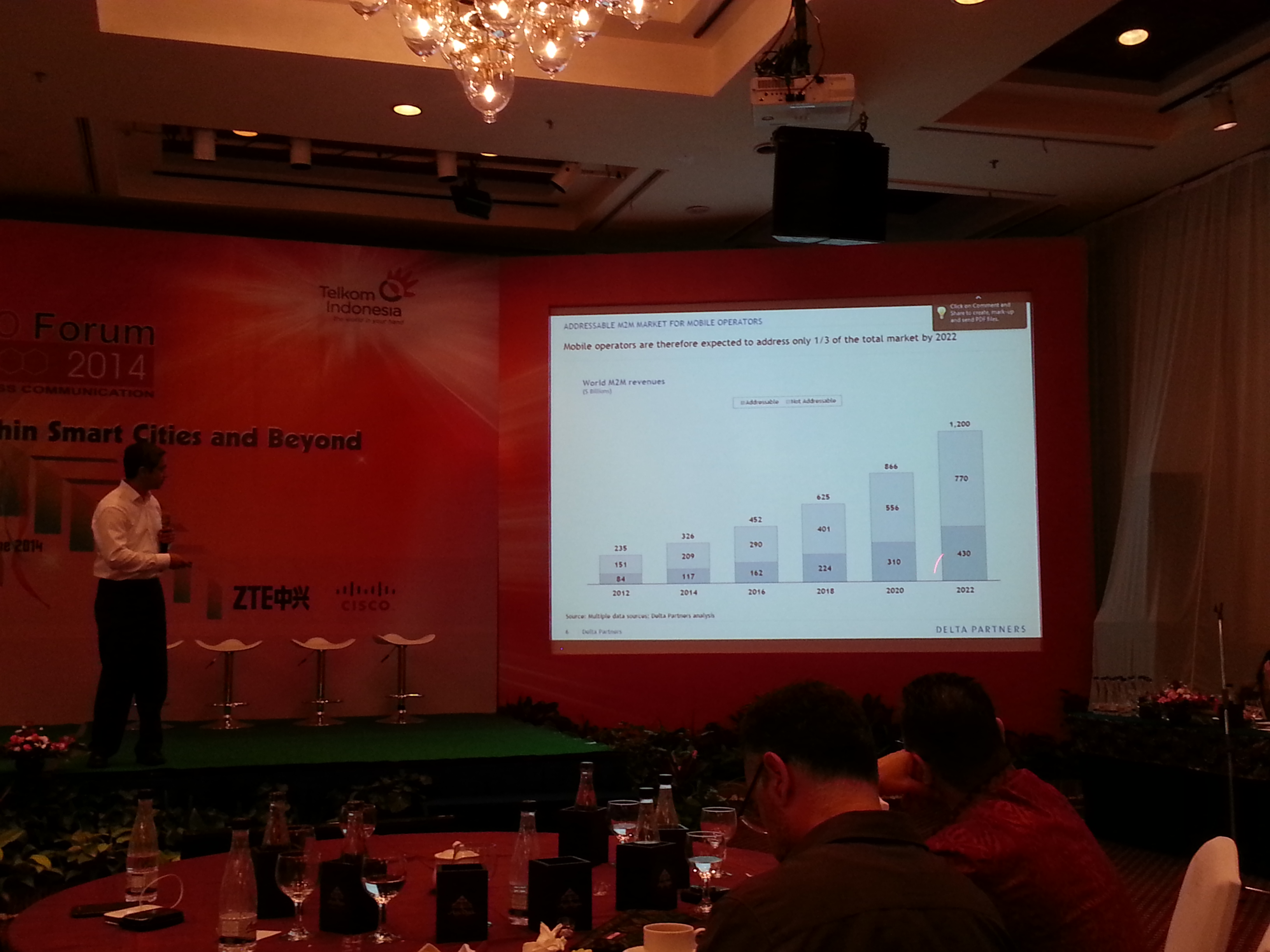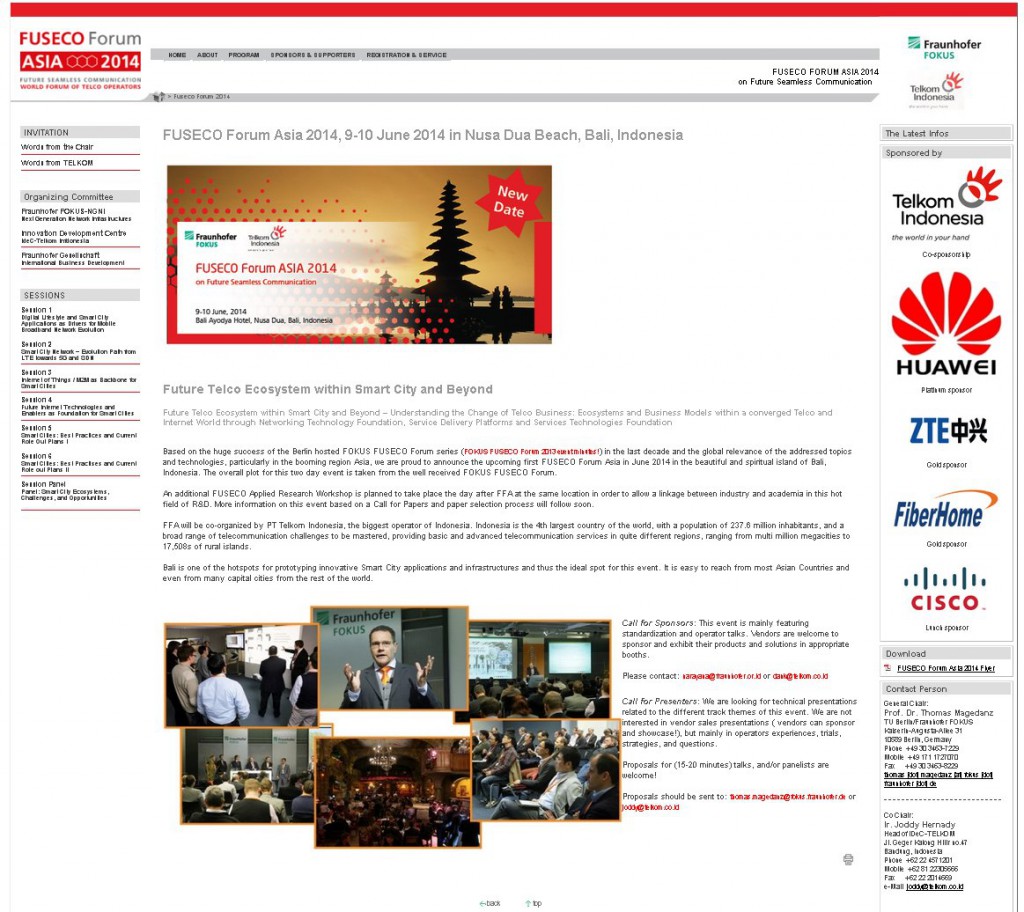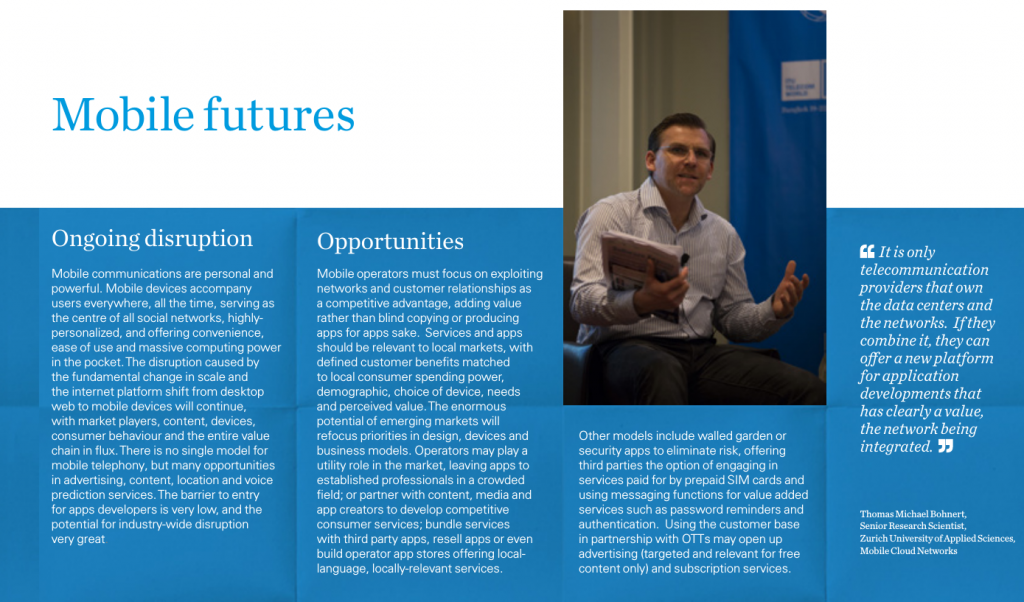Archiv der Kategorie: Future Internet
Opening at the FUSECO Forum Asia
Talk at the FUSECO Forum Asia 2014
09:30-10:30 Session 4: Future Internet Technologies and Enablers as Foundation for Smart Cities at the FUSECO Forum Asia 2014
Chairs: Florian Schreiner, Fraunhofer FOKUS, Germany; Prof. Serge dida, Lip6 Paris, France.
- „FIWARE – A European Perspective on enabling Future Internet and Smart Cities“, T.M. Bohnert, ZHAW on behalf of Telefonica, Spain
- „Innovative eHealth Services on top of the emerging European Smart City Enabler Infrastructure“, Dr. S. Covaci, TU Berlin, Germany
- Q&A Panel
EUCNC 2014 workshop: Mobile Cloud Infrastructures and Services (MCIS)
Workshop Motivation and Background
This workshop addresses the three main topics that are significant for the realization of the Future Internet Architecture, which are the Mobile Networking, Network Function Virtualization and Service Virtualization.
While mobile communication networks have been established decades ago and are still continuously evolving, cloud computing and cloud services became a hot topic in recent years and is expected to have significant impact on novel applications as well as on ICT infrastructures. Cloud computing and mobile communication networks have been considered separate from each other in the past. However, there are various possible synergies between them. This trend supports the use of cloud computing infrastructures as processing platforms for signal and protocol processing of mobile communication networks, in particular for current (4G) and future (5G) generation networks. This enables several opportunities to optimize performance of cloud applications and services observed by mobile users, whose devices are connected to the cloud via wireless access networks. This trend is also in line with the emerging ETSI activities in Network Functions Virtualization (NFV). The “Mobile Cloud Infrastructures and Services” workshop focuses on the thematic area that the EU project MCN is concentrating on and is addressing emerging technologies in cloud services and mobile communication infrastructures. Emphasis will be put on possible integration scenarios and synergies between them.
Workshop Structure
Based on the successful format of the FUNEMS 2013, “Mobile Cloud Networking and Edge ICT “ workshop, we plan to have a good mix of invited keynote talks from key participants in the EU FP7 projects MCN, iJOIN, CONENT and FLAMINGO and peer-reviewed abstracts of the papers to be presented. Moreover, the panel organized in 2013 was highly appreciated by the participants and therefore is proposed to be part of the program in 2014. The speakers of the workshop will form the panel. During the panel session, the presented papers will be used as the starting point for the panel discussions. The programme associated with this workshop is as follows:
Mobile Cloud Infrastructures and Services session (200 minutes + 30 minutes break), Chair Thomas Michael Bohnert (Zurich University of Applied Sciences)
- Thomas Michael Bohnert (Zurich University of Applied Sciences), Welcome speech: EU FP7 Mobile Cloud Networking (MCN) (15 minutes)
- Anna Tzanakaki (University of Bristol) (Invited paper), Title of invited speech: “EU FP7 CONTENT: Virtualizing converged network infrastructures in support of mobile cloud services” (15 minutes)
- Peter Rost (NEC) (Invited paper), Title of invited speech: “EU FP7 iJOIN: Benefits and challenges of cloud technologies for ‘5G” (15 minutes)
- Filip De Turck (University of Gent) (Invited paper), Title of invited speech: “EU FP7 FLAMINGO: Network monitoring in virtualized environments” (15 minutes)
- Joao Soares (Portugal Telecom Inovacao), Andy Edmonds (Zurich University of Applied Sciences), Giada Landi (Nextworks), Luigi Grossi (Telecom Italia), Julius Mueller (Fraunhofer FOKUS), Frank Zdarsky (NEC Laboratories Europe), Title of presentation: “Cloud computing and SDN networking for end to end virtualization in cloud-based LTE systems” (20 minutes)
- Desislava Dimitrova (University of Bern), Lucio S. Ferreira (INOV-INESC | IST), André Gomes (University of Bern | One Source, Consultoria Informática Lda.), Navid Nikaein (EURECOM), Alexander Georgiev (CloudSigma), Anna Pizzinat (Orange), Title of presentation: “Challenges ahead of RAN virtualization” (20 minutes)
Coffee Break (30 minutes)
- Tarik Taleb (NEC Laboratories Europe), Marius Corici (Fraunhofer FOKUS), Carlos Parada (Portugal Telecom Inovacao), Almerima Jamakovic (University of Bern), Simone Ruffino (Telecom Italia), Georgios Karagiannis (University of Twente), Morteza Karimzadeh (University of Twente), Thomas Magedanz (Fraunhofer FOKUS), Title of presentation: “Virtualizing the LTE Evolved Packet Core (EPC)” (20 minutes)
- André Gomes (University of Bern | One Source, Consultoria Informática Lda.), Santiago Ruiz (Soft Telecom), Giuseppe Carella (TU Berlin / Fraunhofer FOKUS), Paolo Comi (Italtel), Paolo Secondo Crosta (Italtel), Title of presentation: “Cloud-based Orchestration of Multimedia Services and Applications” (20 minutes)
Panel discussions (60 minutes)
Previous Editions
The previous edition of this workshop was entitled: “Mobile Cloud Networking and Edge ICT Services”, and it has been organized during the FUNEMS 2013, http://www.futurenetworksummit.eu/2013/. The duration of the workshop was half a day and has been organised in two sessions. The current edition of this workshop will focus mainly only on one of these sessions, “Mobile Cloud Infrastructures and Services”. The workshop was successful and attracted a relatively high number of attendees compared to other parallel workshops. 25- 50 participants have been permanently in the room at the Mobile Cloud Networking and Edge ICT Services 2013.
Workshop Audience
The target audience will be the telecommunication infrastructures and cloud computing research and industry communities, with an emphasis on European FP7 project involved researchers and organizations. The workshop organizers are participating among others in the EU FP7 IP projects: Mobile Cloud Networking (MCN), CONTENT, iJOIN, FLAMINGO and in Standardization Bodies such as Open Networking Foundation and ETSI NFV (Network Function Virtualisation). It is therefore expected that a significant part of the audience and participants will be the communities involved in Standardization Bodies such as Open Networking Foundation and ETSI NFV and the EU FP7 projects that are and will be cooperating with the EU FP7 IP project “Mobile Cloud Networking” (MCN).
ITU Telecom World 2013 – Mobile Cloud Networking Session – Outcomes
About the Mobile Cloud Networking Session. In association with the Mobile Cloud Networking project.
Mobile Cloud Networks combine mobile communications with computing to run network functions in the cloud, enabling new business models at the inflection point between mobile and internet technologies. Running mobile network functions in the cloud reduces costs, and provides elasticity, scalability, on-demand provisioning, calibration and better performance. Operators need to invest in research and human capacity, innovating to create value in-house on this new platform, developing new apps and protocols without being locked in to equipment so is now, to manufacturers. avoid the risk of The losing time market to do space as cloud computing providers begin to move into networks the fusion of telecommunications and IT is not a one-way street.
The full report can be found here http://tinyurl.com/ojhthzw
The 9th IEEE Broadband Wireless Access Workshop co-located with IEEE Globecom 2013
Report provided by Patrick Marsch, Nokia, Andreas Maeder, NEC Laboratories Europe, Arun Ghosh, AT&T Labs, Giridhar K, IIT Madras, Peter Fertl, BMW Group Research & Technology.
The 9th International Workshop on Broadband Wireless Access (BWA), in co-location with IEEE Globecom 2013 in Atlanta, US, marked the successful continuation of what has become the most renowned workshops series alongside IEEE communications conferences. The series aims at bringing together leading experts from academia and industry to discuss latest research and trends in a particularly focused and interactive way.
The organizing committee of the 9th BWA has been:
- General Chairs: Patrick Marsch, Nokia Solutions and Networks, and Andreas Maeder, NEC Laboratories Europe.
- TPC Chairs: Arun Ghosh, AT&T Labs, Giridhar K, IIT Madras, and Peter Fertl, BMW Group Research & Technology.
- Steering Committee: Thomas M. Bohnert, Zurich Univ. of Applied Sciences, Dirk Staehle, DOCOMO Communications Laboratories Europe, and Gabor Fodor, Ericsson Research.
This year, the workshop attracted 85 paper submissions, out of which 31 were accepted for publication, yielding an acceptance ratio of 36%. With about 50 participants, the workshop was one of the most successful instances since the beginning of the series.
Out of the accepted papers, 20 were presented in oral form in four technical sessions:
Novel PHY techniques, e.g. looking into novel multi-carrier techniques, modified OFDM approaches or faster-than-Nyquist signaling
Novel MAC techniques, e.g. focusing on scheduling and MAC design in wireless multi-hop or mesh networks
Multi-antenna and cooperative communications, investigating interference alignment, millimeter-wave beam alignment and cooperative relaying
Spectrum, cognitive radio and HetNet, e.g. covering spectrum sensing or power allocation in cognitive networks, or dual connectivity and network selection in heterogeneous networks
The remaining 11 papers were presented as posters, including short teaser talks, and covering a wide range of topics like SON, context-aware mobility management, demand control, propagation and deployment.
The paper presentations were complemented with five invited speeches from renowned representatives of mobile network operators, network vendors and academia. All speeches were focused on the future of broadband wireless access, in particular the upcoming 5th generation of cellular communications.
In the first speech from Hank Kafka, VP Radio Access & Devices, AT&T, already the title “The Next Next Generation” reminded that just lately LTE was introduced as a next generation – and defined by its abbreviation to be of longer-lasting nature – so that the introduction of yet another generation has to be carefully considered. After highlighting the current data traffic growth and consequent network densification, Hank stated future network requirements, like increased spectral efficiency, substantially more devices, and lower cost. He touched potential solutions like massive MIMO or novel PHY and MAC approaches, but emphasized that any non-backward-compatible technology would have to deliver substantial gains in spectral efficiency, throughput and cost to be justified, considering the large recent operator investments into LTE-A.
The next speaker, Bill Payne, VP Small Cells and CDMA, Nokia Solutions and Networks, emphasized the strongly expanded application space beyond 2020. For instance, the Internet of Things with trillions of connected devices and the usage of wireless connectivity for industrial or vehicular traffic automation will offer new business opportunities, but also pose severe novel communications requirements, like latency, reliability or strongly reduced device cost and power dissipation. Bill stated that 5G will require both an evolution of existing technologies like LTE-A and Wi-Fi as well as novel radio access technologies designed to meet the very different nature of future application needs. As examples of such technologies, Bill gave an insight into the novel enhanced local area and mmWave technology NSN has been investigating in the last years.
Gerhard Fettweis, Vodafone Chair Professor, TU Dresden elaborated in detail on the novel use cases that may define 5G, like user-specifically rendered 3D, augmented reality, industry automation for user-tailored products, and traffic control. He emphasized that 5G will be about using wireless communications not only for content, but also for steering and control, and stated the key 5G requirements as throughput, latency and reliability. Gerhard discussed solutions to meet these requirements, such as generalized frequency division multiplexing (GFDM) as an enabler for lower air interface latency. He concluded his talk by pointing out the interesting future question of where in the infrastructure data and applications should reside in the context of e.g. low latency, and the potential necessity to “hand over” applications between network nodes.
Gabor Fodor, Master Researcher, Ericsson, pointed out that network nodes and devices may converge towards similar complexity, and that we will see much more transmission modes beyond 2020, including e.g. device-to-device communication. He emphasized that 5G may evolve from the classically decoupled concepts of uplink and downlink to an optimization of two-way communication incorporating network coding and network information theory. Gabor also touched various other research fields of Ericsson, like massive MIMO, shared spectrum access and mmWave technology.
Chih-Lin I, Chief Scientist Wireless Technologies, China Mobile Research Institute put an emphasis in her speech on the aspect of energy efficiency, and highlighted the paradigm change from designing wireless communications for optimized spectrum efficiency to jointly optimized energy efficiency and spectrum efficiency. She considered “Green and Soft” as the key words for BWA in the future. Specifically, she highlighted 5 key focus areas in China Mobile’s research effort: Rethink Shannon, Rethink Ring and Young, Rethink Signalling and Control, Invisible Base Stations, Small Cell New Spectrum. Chih-Lin also stated massive MIMO and Full Duplex as topics of interest for 5G, and provided some detailed considerations on an irregular antenna array her institute is designing.
The workshop was concluded by a panel discussion among the invited speakers, moderated by Patrick Marsch from Nokia Solutions and Networks. It started with the question which future application requirements would justify novel, non-backward-compatible wireless technologies. The panelists agreed on latency as a clear case, while reliability may be achieved through an evolution of existing technology. Also the need for device-to-device communications was stated, but here the operators commented that the business case behind this was not clear yet. Regarding expected technology disruptions, the panelists concluded that air interface modifications, mmWave technology, system architecture and protocol stack would be most likely fields. The speakers then elaborated on whether there can be a “one-size-fits-all” approach in 5G, able to address all requirement dimensions throughput, latency, reliability and power/cost, or whether there will be technologies optimized for specific use cases. Nobody was able to precisely answer this question, but the operators emphasized the need for compelling business cases to justify dedicated radio access technology only for some use cases. After venturing into the topic of spectrum usage, the panel was concluded with an outlook on how the wireless communications ecosystem may change beyond 2020. It was for instance discussed that network vendors may face the challenge of moving towards a consumer market as the number of base stations starts equalling that of devices, but that edge computing may be a novel business opportunity for both network vendors and network operators.
At this point, we would like to express our sincere gratitude to all persons who have made this workshop a great success, such as the Technical Program Committee which has mastered a total of 255 paper reviews, Matthieu Bloch, Kwang-Cheng Chen and John Barry as the overall workshop chairs for Globecom 2013, which have been very responsive and supportive, as well as the session chairs and invited keynote speakers and panelists.
Talk and Panel at the International FI-PPP workshop, FUSECO Forum 2013, Berlin
Text borrowed from the original post publised at the XiFi Website
With participation of more than 50 guests and speakers the international FI-PPP workshop successfully provided a comprehensive overview of the status of all currently running projects of the FI-PPP programme. By involving FIRE and EIT ICT Labs representatives, synergies and sustainability options were discussed and an outlook on the next phase was provided.
The workshop started with an overview of the current status of the FI-PPP at programme level. Subsequently, the status of the FI-PPP Core Platform [FIWARE], FI-PPP’s Usage Areas [FISTAR, FI-SPACE, FI-CONTENT, FINESCE, FITMAN), as well as the status and achievements of FI-PPP’s Infrastructure and Capacity Building projects [INFINITY, XIFI] were presented.
Additionally, a number of European FI-PPP nodes provided presentations about their status highlighting that they are already offering FI-PPP’s Generic Enablers for application development and deployment, and their portfolio is expected to grow over time. Live demonstrations were present at the event and showed capabilities of FI-PPP node deployments as well as Generic Enabler usage in Usage Areas.
With representatives and presentations from the European Commission, FI-PPP’s programme-wide coordination action CONCORD, Europe’s Future Internet Research and Experimentation (FIRE) initiative and the European Institute of Innovation and Technology (EIT) ICT Labs several options for sustaining FI-PPP’s results and approaches for future exploitations were discussed and synergies identified. Panel discussions about the upcoming phase III of the FI-PPP, as well as best strategies for participation of SMEs concluded the workshop.
A highlight at the demonstration space at the FUSECO Forum was the first demonstration of an early trial project running over an infrastructure node of the program. In particular the FI-STAR project demonstrated a first simple application running over the XIFI node available in Berlin.
Webcast: ITU Telecom World Forum 2013, Panel Session “Mobile Cloud Networks”, Thursday 21 November (16.15-17:45, Bangkok)
The panel sessions will be webcast (audio and video). Questions submitted via a Twitter feed using the hashtag #ITUWORLDLIVE or by SMS or through the ITU Telecom webcast portal will be displayed on the Moderator’s laptop screen during the session.
Mobile Cloud Networks
Thursday, 21 November 2013, 16:15 – 17:45, Jupiter 9
Innovative services and products over the next decade will be strongly driven by cloud computing technologies. Research communities on cloud technologies will need to address challenges such as radio access in the cloud, new opportunities for sharing of infrastructure, open source, SDN (software defined networks), new CDN (content delivery networks), and ICN (information centric networks). Globally, green requirements, performance and scalability studies and related impacts on policy, regulation and standardisation will also need to be addressed. Telecommunication networks need to be prepared for the requirements coming from cloud services, transporting the corresponding information in an effective and efficient way. The cloud concept is being brought into network architectures, by introducing virtualisation into all signal processing and information storage in the networks, and the service provision concept as a replacement for current network node functionalities. Game developers, network operators, OTT content providers and community operators will have a big role to play in these new paradigms. A broad view will be taken, addressing perspectives of innovation, standardisation, business models, implementation, roadmap, and so on.
Moderator
- Dr Thomas Michael Bohnert, Zurich University of Applied Sciences, Switzerland
Panellists
- Prof. Luis M. Correia, Associate Professor, Instituto Superior Técnico – Technical University of Lisbon, Portugal
- Dr Neil Davies, Founder and Chief Scientist, Predictable Network Solutions, United Kingdom
- Mr Latif Ladid, Founder & President, IPv6 Forum, Luxembourg
- Mr Peter Riedel, Executive Vice-President, Rohde & Schwarz, Germany
- Dr Masao Sakauchi, President, NICT, Japan
Panel at the ICT 2013 Event in Vilnius
Future Internet: The „Internet of Everything“ Economy – The Next 10 Years
Moderator:
Panelists:
Presenting MCN at the EU-Korea Workshop
Invited to the „Korea-EU Workshop: Exploring common research interests in the Future Internet“, 30 September, 1st and 2nd of October 2013
This event follows the 2012 ISTAG report having identified Korea as a relevant third country to jointly perform targeted research in the field of Future Internet. It also benefits from the fact that both Korea and the EU have started focused programmatic initiatives in the Future Internet domain. The purpose of this workshop is consequently: In the short term, to identify Korean and EU projects with similar scopes and objectives to favour „twinning“ and information exchanges for the mutual benefits of the running activities; in the medium term, to identify a limited and focused set of research issues of common interests in the two regions which could form the basis of specific joint research in the various upcoming implementations of the Horizon 2020 research programme.
There is an extensive track on „Innovative Internet Architectures“, and this is a perfect place to present „Mobile Cloud Networking„.
